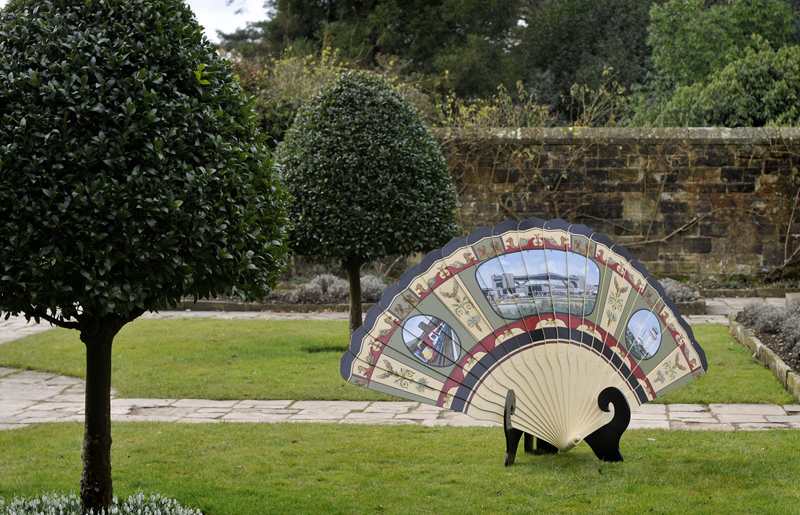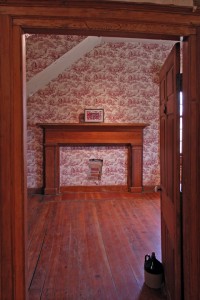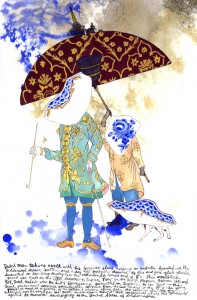This is the fifteenth in a series of interviews with each of the Sondheim Award Semifinalists. Finalists will be announced in mid-April, and will be on exhibit at the Walters Art Museum June 21 to August 17; those not selected as finalists with be exhibited at the Decker, Meyerhoff and Pinkard Galleries at MICA July 17 to August 3, 2014. (UPDATE: Finalists have been announced, congrats Lauren!)
Name: Lauren Frances Adams
Age: 34
Website: http://www.lfadams.com
Current Location: Remington, Baltimore, MD
Hometown: Snow Hill, North Carolina
School: BFA, UNC-Chapel Hill in studio art and art history, with Honors; MFA, Carnegie Mellon University

Grand Tour Fan, 4′ x 6′, sintra, paint, hardware and wood, 2012, site-specific project at Nymans House and Gardens in Sussex, England
Current favorite artists or artwork: Rediscovering Meyer Vaisman and Adriana Varejão for their mashups of the political and decorative. All time favorite artists: Robert Rauschenberg, who challenged painting with print and sculpture, David Mabb, a contemporary British artist who thinks carefully about how utopia is tied to the domestic, Sigmar Polke, who invokes the decorative within and against abstraction and figuration in paint, Rodchenko and Stepanova, whose failures were the most noble, and my students, who are brilliant and excite me with their fearlessness and curiosity, and my artist friends, who in their varying levels of artistic engagement remind me that being an artist is a lifetime pursuit. The artists I love to teach to my students: Van Gogh, Rembrandt, William Kentridge, Vermeer, Fred Wilson, Matisse, Nedko Solakov, Magritte, Helen Frankenthaler, Kerry James Marshall, Wangechi Mutu, Ana Mendieta, Morris Louis, Mona Hatoum, Max Ernst, Nicole Eisenman, Philip Guston, Francis Picabia, Katharina Grosse. . .
What is your day job? How do you manage balancing work with studio time with your life? I teach painting and drawing full-time at MICA. I love working with students. The best is when the concerns in my studio align with those of my students. I find this maxim useful: You teach what you most need to learn. So, it’s a mutual learning environment. I’m very lucky to have a teaching job, particularly because my work is maybe more free from market concerns, which typically haven’t been kind to installation work and political work. I don’t have full time gallery representation, so being a free agent really suits my artistic ambitions.

Installation view of Elusive Contact, Rotating History Project at Clermont Forum II, Clermont Foundation, Virginia, 2014
How would you describe your work, and your studio practice? An attempt to elevate the forgotten or overlooked. An investigation of exhausted grand narratives.
What part of artmaking to you like or enjoy the most? The least? I like when ideas seem to come out of nowhere after you’ve been banging your head for days. Synapses firing in the most unusual ways lead to creative breakthroughs. The worst is that you can’t predict that — you can set up conditions hoping it’ll happen, but you can’t force it. I like the positive outcomes of being curious about our world.
What research do you do for your art practice? I am a completely research-based artist. Even though my work is personal in that I’m exploring aspects of my identity, history, and culture that I care deeply about, I am most inspired by archival investigations and the illusion of reality that the archive presents. I also enjoy the kind of code-breaking hunt that archival research allows. For the current project I’m working on, Elusive Contact (When you cut your finger, bandage the knife), I’ve been doing so much research with images that are difficult to locate the provenance of that my whole practice feels like it’s based upon reverse Google image searches. However, I always enjoy on-site research, and I am particularly inspired by the ways in which museums and cultural heritage sites display historic information.

Elusive Contact #19
(Umbrella decorated with the Dutch Ridderzaal contemporary throne pattern, also with Tournai blue and gold plate sherds from Den Haag, Netherlands, late 1700’s/Woodblock print, ‘Dutch man taking a walk with his Javanese slave’, 1780’s, Nagasaki-e, Japan, now in the British Museum), Gouache on paper, 14” x 20”, 2014
What books have you read lately you would recommend? Movies? Television? Music? Right now my reading is all non-fiction related to my practice: Blind Memory: Visual Representations of Slavery in England and America 1780-1865, by Marcus Wood and Representations of Slavery: Race and Ideology in Southern Plantation Museums by Jennifer L. Eichstedt and Stephen Small. I’m also digging back in with the catalogues from recent and historical art exhibitions: Pattern and Decoration: An Ideal Vision in American Art and Interwoven Globe: The Worldwide Textile Trade (from a recent exhibition at the Metropolitan Museum). As for sound, I listen to NPR and podcasts in my studio, I’m currently a fan of Marc Marin’s WTF podcast and Bad at Sports art talk podcast out of Chicago. I’m a complete cinephile and two recent films come to mind: Slavoj Zizek’s Pervert’s Guide to Cinema and Steve McQueen’s 12 Years a Slave.
Do you ever get in creative dry spells, and if so, how do you get out of them? Yes, this is normal and a universal experience. I usually do what I tell my students to do: just start making something, get your hands dirty, and even if it’s a failure it will usually provoke something that is much more interesting.
How do you challenge yourself in your work? Obviate the known by choosing to make things/engage with ideas that I don’t yet understand.
What is your dream project? Collaborative artist in residence with William Kentridge and Fred Wilson at the living history museum and cultural heritage site in Jamestown, Virginia
